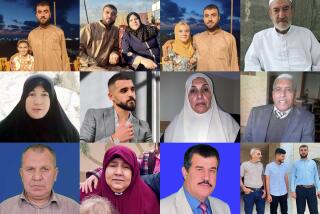Israeli Schools Revisit ’56 Massacre of Arabs
- Share via
JERUSALEM — It was after dusk 43 years ago today. Arab villagers straggled home from work in the fields, unaware that the Israeli army had imposed a curfew.
Border police halted one group of Arabs near the village of Kafr Qasem and fired on them at close range. Other Arabs were shot as they fled. In all, 47 people, including 15 women and 11 children, were killed.
That ugly chapter in Israel’s history is for the first time getting a formal, systemwide airing in Israeli schools. Today and throughout the school year, students are being asked to discuss the massacre and draw moral lessons from the actions and decisions that led to it.
The discussion of Kafr Qasem comes at the urging of Education Minister Yossi Sarid. His instructions are part of the evolving and more critical way in which Israeli education is beginning to look at the country’s past.
“We won’t ignore [the massacre] and we won’t try to cover up the shame,” Sarid wrote Israeli civics teachers earlier this month, “but instead we shall cope with it openly and honestly.”
The 1956 massacre at Kafr Qasem occurred on the day Israel invaded the Sinai peninsula in response to repeated attacks from Palestinian guerrillas and an Egyptian blockade on the southern Israeli port of Eilat. To defend against a possible counter-assault from Jordan along Israel’s eastern flank, the army on Oct. 29 placed a 5 p.m. curfew on Kafr Qasem and other Arab villages in the area. The army also issued orders to shoot anyone who violated the curfew.
But many villagers had spent the day working in distant fields and were unaware of the curfew, which wasn’t ordered until 3 p.m. Border police seconded to the army opened fire on scattered groups returning home on foot and bicycles and in trucks.
Eight police officers were later convicted by a military court. Judge Binyamin Halevy ruled that they had a duty to disobey such a patently illegal order to shoot.
Sarid, who took office three months ago and is a member of the leftist Meretz Party, stressed in his letter to teachers that the lesson students should take from examination of the episode is one of judgment.
“It is precisely people who, like me, see military service as an important national and personal mission of the first order, it is precisely we who must remember and remind others about the massacre at Kafr Qasem . . . so as to ensure that our students, both boys and girls, will know how to listen attentively to an order and recognize an illegal order,” Sarid wrote.
The Kafr Qasem massacre has been mentioned in Israeli history books, but this is the first time that it has been examined at length and in a systematic manner, Education Ministry spokeswoman Rivka Shraga said.
It is part of what Education Ministry officials describe as a new “myth-breaking” approach to the teaching of Israeli history. Three textbooks, for example, were introduced into schools this year that challenge such long-held views as Israel’s self-perception that it was an underdog during the 1948 War of Independence.
The Kafr Qasem discussion and other changes to the curriculum have been applauded by the Israeli left but roundly condemned by the right. The conservative religious newspaper Yated Neeman charged in a front-page article last week that Sarid was “encouraging heresy in the schools.”
The victims at Kafr Qasem were Arab citizens of Israel. Today, Arab Israelis welcome Sarid’s initiative but call it overdue and inadequate.
“It is a positive step, but it is not enough,” said Issam Mahoul, an Arab member of the Israeli Knesset, or parliament. “This is the first time official Israel is expressing sorrow, but it’s not yet expressing responsibility. We demand they take responsibility for this massacre.”
More to Read
Sign up for Essential California
The most important California stories and recommendations in your inbox every morning.
You may occasionally receive promotional content from the Los Angeles Times.














